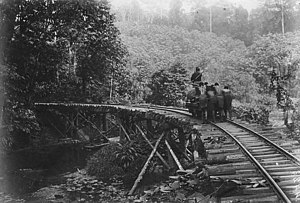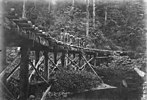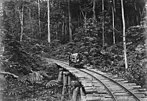Narrow-gauge railway Eséka – Makak
| Narrow-gauge railway Eséka – Makak | |||||||||||||||||||||||||||||||||||||
|---|---|---|---|---|---|---|---|---|---|---|---|---|---|---|---|---|---|---|---|---|---|---|---|---|---|---|---|---|---|---|---|---|---|---|---|---|---|
|
Wooden makeshift bridge over the Petite Malumé
| |||||||||||||||||||||||||||||||||||||
|
Today's route
| |||||||||||||||||||||||||||||||||||||
|
Route 1915
| |||||||||||||||||||||||||||||||||||||
| Route length: | 40 km | ||||||||||||||||||||||||||||||||||||
| Gauge : | 600 mm ( narrow gauge ) | ||||||||||||||||||||||||||||||||||||
|
|||||||||||||||||||||||||||||||||||||
The narrow-gauge railway Eséka – Makak was a 40 km long narrow-gauge railway with 600 mm gauge from Eséka to Makak in the German colony of Cameroon , today's Republic of Cameroon, operated by the Germans until November 1915 .
history
Construction and sabotage by the Germans
The railway line was built during the German colonial era. During the First World War , the German troops had to leave the French-occupied area and destroyed the infrastructure and rail vehicles as part of the sabotage on the retreat. On November 22nd, 1915 at 5 a.m. they carried out the last large demolition.
Recommissioning by the French
In December 1915, the French put 50 narrow-gauge freight carts back into operation, which they had repaired and equipped with hand brakes in the Douala workshops in November 1915 for the transport of supplies and food. On January 4, 1916, eight narrow-gauge railway locomotives were found during an investigation in Makak, but they were not functional because their connecting rods, fittings and pipes had been removed. The kettles had been made unusable by explosions from explosives in the fire box . On January 20, 1916, some of the parts removed from the locomotives were found in Makak. The next day it was found that the locomotives' fire boxes had been badly damaged by the explosions and that the locomotives were therefore completely unusable. On January 24, 1916, however, the two-axle tank locomotive N ° 112 was put back into operation. Upon request, the chief engineer of the West African Planting Company Victoria offered to provide a three-axle narrow-gauge railway tank locomotive. This was delivered disassembled in two parts. On February 2, 1916, after an incorrect operation of the hoist, a rope broke, as a result of which the senior officer Le Révérend was seriously injured with internal bruises and a broken pelvis. However, the locomotive was put back into service on February 21, 1916. On April 20, 1916, the route was reopened for the commercial transport of passengers and goods.
From November 18, 1915 to January 22, 1916, the French army encountered exceptionally difficult terrain while forcing the Njogo-Ngond massif along the narrow-gauge railway. The ravines were covered with thick forest. They were deserted and with no paths, which made lateral progress difficult, but which was necessary due to the tenacity of the enemy well-positioned on the front lines. There was little direct line of sight and no torches could be seen at night. It took the whole day, sometimes two days, to move the troops forward. That explains the slowness of progress. It took the troops 28 days of daily fighting, 1,400 shots and around 300 casualties on the French side to cover the 30 kilometers that Eséka and Mangelès are as the crow flies.
Modernization of the Decauville railway around 1921
The Decauville railway, which was abandoned in 1914 and damaged by the Germans, was constantly repaired after it was put back into operation. Most of the tracks and the wagons, on which the non-ferrous metal bearing shells had been removed from the bearings, were repaired, which made it possible to gradually equip the construction sites for the meter-gauge railway with the transport vehicles necessary for good personnel deployment.
The Decauville Railway was reopened in April 1920 and had a significant volume of traffic as early as 1921. At various points along the route of the new meter-gauge route, deliveries of ballast from excavated material were heaped up for future use. The 600 mm track from N'Jock to Makak, which also served to supply the construction sites, consisted of 2 sections of 7 km each with light rails weighing 9 kg / m per meter, while the rest of the route had heavier rails 12 kg / m.
Fifteen kilometers of the new Decauville tracks ordered in 1921 with a weight of 12 kg / m per meter were delivered at the beginning of 1922. The substitution of the first 7 km long section was then carried out in the area between route kilometers 35 and 42 (or 55 and 62); the substitution of the remaining section was carried out in 1925.
Behind N'Jock, the Decauville Railway had a continuous gradient of 55 per thousand over a length of about 4 kilometers, which made traction of the trains particularly difficult. In order to improve the operating conditions, it was decided to lay 7 kilometers of new Decauville tracks on the new metric route as soon as it was completed, which were connected to the previously operated track with a gauge of 600 mm at route kilometers 188 and in the Pomlep- Valley should be tried out. This work was completed at the end of December, and the trains started running on this new line in 1925, which now only had a maximum gradient of 11 per thousand.
With the commissioning of the new Decauville track, the tracks of the old, 6-kilometer-long section became available with 12 kg / m of track, which will then be used as a replacement for the remaining 9 kg / m of rails on the track operated from km 45 to km 52 . The 9 kilogram rails that were released were then used on the construction sites.
In 1922, the Railway Department acquired two inspection trolleys for the Decauville Track from N'Jock to Makak, for a total of 70,200 francs. At the same time, in 1922, the Decauville works built new platform trucks and construction site trains for the workers. Thanks to these vehicle acquisitions, the situation has improved and the Decauville Railway has been able to meet the growing demands of its traffic.
The operating results of the Decauville Railway in 1922 were considered satisfactory and demonstrated the importance of this line, but its performance was limited and suggested that the future extension of the meter-gauge railway from the center towards Yaoundé would find attractive and profitable traffic.
Re-gauging
On January 1, 1922, gauging began on meter gauge . In the difficult section Eséka – Makak, the route followed the winding and steep Maloumé valley and was hindered by the rains that caused many landslides in 1924 in particular. The rest of the work went smoothly, so that the meter-gauge route arrived in Yaoundé at km 308 on August 15, 1927. In 1955, with the construction of the railway bridge from Bonabéri over the River Wouri to Douala, the northern railway was connected to the Mitteland railway.
Extension after the declaration of independence
After the plebiscite of 1961 decided to link English-speaking West Cameroon to the Republic of Cameroon , the Régie des Chemins de Fer du Cameroun (REGIFERCAM) had the 30 km long Mbanga - Kumba section measured as an extension of the northern line and built until 1969. The planning of the Trans-Cameroonian Railway, decided in 1961, referred to the plans for the Douala – Chad Railway developed in 1945 by engineer Paul Darnault. It was commissioned by the Office du Chemin de Fer Transcamerounais (OCFT), an organization founded by the Cameroonian government. The first two sections, financed by a consortium of investors and built by the Italian company Cogefar, were put into operation in 1969 ( Yaoundé - Belabo , 296 km) and 1974 (Belabo - Ngaoundéré , 327 km). Instead of the steep and winding route of the original route, the new Douala – Yaoundé route was built from 1975 to 1987, which is 46 km shorter than the first route.
See also
Individual evidence
- ^ A b E. Chardy: Journal des marches et operations de la section des chemins de fer de campagne Cameroun du 6 septembre 1914 to 20 avril 1916. In: Corps expéditionnaire du Cameroun. Section de chemin de fer. April 20, 1916.
- ↑ a b c Colonne Mangelès - Ebolowa Journal des marches et opérations, November 18, 1915 ~ January 22, 1916.
- ^ Lieutenant-Colonel Faucon: Régiment de marche des tirailleurs sénégalais du Cameroun Journal de marche, October 1, 1915 - February 2, 1916.
- ^ France. Ministère des colonies: Report annuel du Gouvernement français à l'Assemblée générale des Nations Unies sur l'administration du Cameroun: placé sous la tutelle de la France. Paris, 1922, especially page 117.
- ↑ a b Jean-Louis Chaléard, Chantal Chanson-Jabeur and Chantal Béranger: Le chemin de fer en Afrique. Karthala, 2006. pp. 22-23.
Coordinates: 3 ° 33 ′ 43.6 " N , 10 ° 53 ′ 22.2" E




